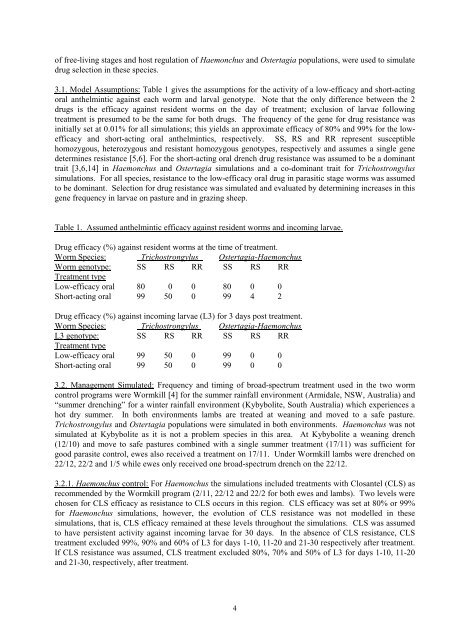Computer models of parasite populations and anthelmintic ... - CSIRO
Computer models of parasite populations and anthelmintic ... - CSIRO
Computer models of parasite populations and anthelmintic ... - CSIRO
You also want an ePaper? Increase the reach of your titles
YUMPU automatically turns print PDFs into web optimized ePapers that Google loves.
<strong>of</strong> free-living stages <strong>and</strong> host regulation <strong>of</strong> Haemonchus <strong>and</strong> Ostertagia <strong>populations</strong>, were used to simulate<br />
drug selection in these species.<br />
3.1. Model Assumptions: Table 1 gives the assumptions for the activity <strong>of</strong> a low-efficacy <strong>and</strong> short-acting<br />
oral <strong>anthelmintic</strong> against each worm <strong>and</strong> larval genotype. Note that the only difference between the 2<br />
drugs is the efficacy against resident worms on the day <strong>of</strong> treatment; exclusion <strong>of</strong> larvae following<br />
treatment is presumed to be the same for both drugs. The frequency <strong>of</strong> the gene for drug resistance was<br />
initially set at 0.01% for all simulations; this yields an approximate efficacy <strong>of</strong> 80% <strong>and</strong> 99% for the lowefficacy<br />
<strong>and</strong> short-acting oral <strong>anthelmintic</strong>s, respectively. SS, RS <strong>and</strong> RR represent susceptible<br />
homozygous, heterozygous <strong>and</strong> resistant homozygous genotypes, respectively <strong>and</strong> assumes a single gene<br />
determines resistance [5,6]. For the short-acting oral drench drug resistance was assumed to be a dominant<br />
trait [3,6,14] in Haemonchus <strong>and</strong> Ostertagia simulations <strong>and</strong> a co-dominant trait for Trichostrongylus<br />
simulations. For all species, resistance to the low-efficacy oral drug in parasitic stage worms was assumed<br />
to be dominant. Selection for drug resistance was simulated <strong>and</strong> evaluated by determining increases in this<br />
gene frequency in larvae on pasture <strong>and</strong> in grazing sheep.<br />
Table 1. Assumed <strong>anthelmintic</strong> efficacy against resident worms <strong>and</strong> incoming larvae.<br />
Drug efficacy (%) against resident worms at the time <strong>of</strong> treatment.<br />
Worm Species: Trichostrongylus Ostertagia-Haemonchus<br />
Worm genotype: SS RS RR SS RS RR<br />
Treatment type<br />
Low-efficacy oral 80 0 0 80 0 0<br />
Short-acting oral 99 50 0 99 4 2<br />
Drug efficacy (%) against incoming larvae (L3) for 3 days post treatment.<br />
Worm Species: Trichostrongylus Ostertagia-Haemonchus<br />
L3 genotype: SS RS RR SS RS RR<br />
Treatment type<br />
Low-efficacy oral 99 50 0 99 0 0<br />
Short-acting oral 99 50 0 99 0 0<br />
3.2. Management Simulated: Frequency <strong>and</strong> timing <strong>of</strong> broad-spectrum treatment used in the two worm<br />
control programs were Wormkill [4] for the summer rainfall environment (Armidale, NSW, Australia) <strong>and</strong><br />
“summer drenching” for a winter rainfall environment (Kybybolite, South Australia) which experiences a<br />
hot dry summer. In both environments lambs are treated at weaning <strong>and</strong> moved to a safe pasture.<br />
Trichostrongylus <strong>and</strong> Ostertagia <strong>populations</strong> were simulated in both environments. Haemonchus was not<br />
simulated at Kybybolite as it is not a problem species in this area. At Kybybolite a weaning drench<br />
(12/10) <strong>and</strong> move to safe pastures combined with a single summer treatment (17/11) was sufficient for<br />
good <strong>parasite</strong> control, ewes also received a treatment on 17/11. Under Wormkill lambs were drenched on<br />
22/12, 22/2 <strong>and</strong> 1/5 while ewes only received one broad-spectrum drench on the 22/12.<br />
3.2.1. Haemonchus control: For Haemonchus the simulations included treatments with Closantel (CLS) as<br />
recommended by the Wormkill program (2/11, 22/12 <strong>and</strong> 22/2 for both ewes <strong>and</strong> lambs). Two levels were<br />
chosen for CLS efficacy as resistance to CLS occurs in this region. CLS efficacy was set at 80% or 99%<br />
for Haemonchus simulations, however, the evolution <strong>of</strong> CLS resistance was not modelled in these<br />
simulations, that is, CLS efficacy remained at these levels throughout the simulations. CLS was assumed<br />
to have persistent activity against incoming larvae for 30 days. In the absence <strong>of</strong> CLS resistance, CLS<br />
treatment excluded 99%, 90% <strong>and</strong> 60% <strong>of</strong> L3 for days 1-10, 11-20 <strong>and</strong> 21-30 respectively after treatment.<br />
If CLS resistance was assumed, CLS treatment excluded 80%, 70% <strong>and</strong> 50% <strong>of</strong> L3 for days 1-10, 11-20<br />
<strong>and</strong> 21-30, respectively, after treatment.<br />
4
















